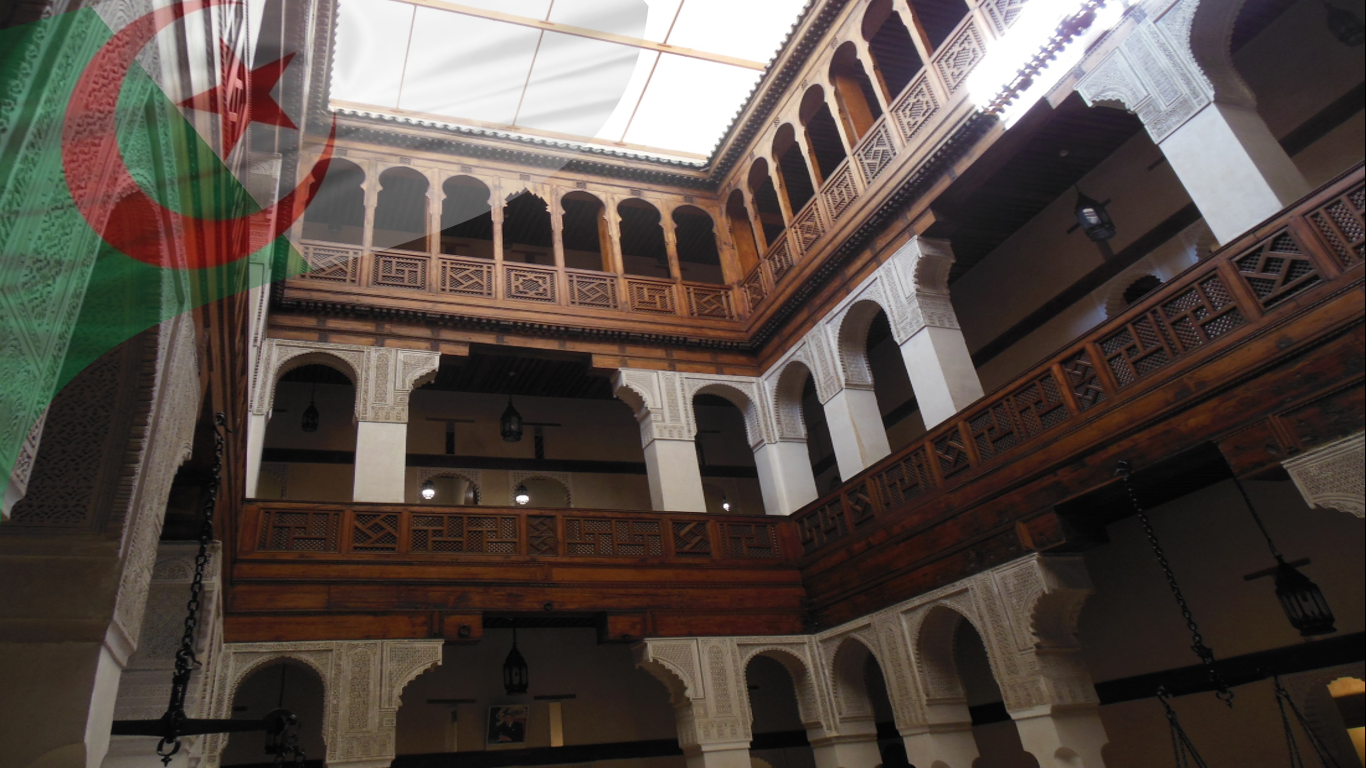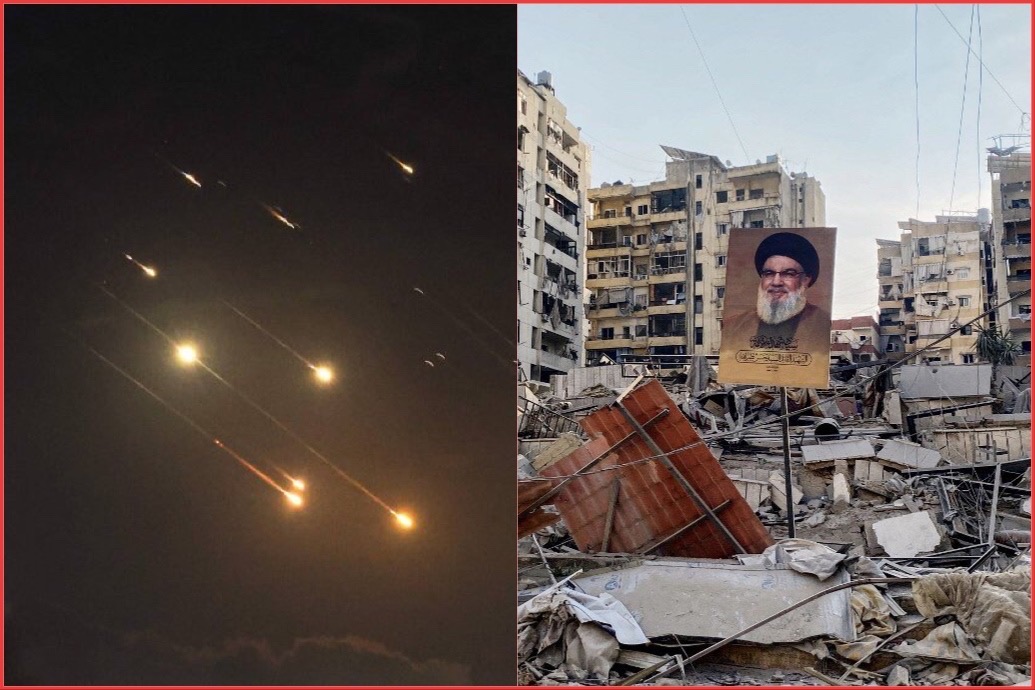On the night of 1 October Tel Aviv officially announced launching a land offensive against Lebanon. With this, the open war had begun, which was clearly coming for months and was unmistakably close with the assassination of much of Ḥizb Allah’s leadership in September. And thus the regional war that had started on 7 October 2023 expanded to its second big phase moving the center of Israeli attention away from Gaza and now focusing on crushing Lebanon. Which by all indications, does not seem to be the last phase in the Netanyahu cabinet’s war plan, much more like a prelude to even bigger operations expanding to Syria, and even beyond.
After assassinating much of Ḥizb Allah’s military and political leaders Tel Aviv was sure that the right time for a land operation had arrived, before the Lebanese Resistance had time to reorganize, choose its new leaders, and receive significant support from Iran and Syria. It seemed that a new reality can be achieved, not only with Lebanon but in the region as well, as Netanyahu put it: “We create a new Middle East!”
This operation broke down immediately, as on the very first day of the operation nothing happened, and that night the Israeli regime received the so far biggest Iranian missile response within Operation True Promise 2. This showed a surprising resilience and precision by the Iranian state, which both Washington and Tel Aviv believed nor willing to risk, nor capable of mounting such a move. They were wrong. Since then, while the results of the Iranian operation are still debated and Tel Aviv threatens with a crushing response, all attempts of the Israeli land forces in Lebanon have failed miserably. After almost two weeks Tel Aviv could not advance at all from the border, yet at the same time suffered massive casualties within its most elite troops. And its problems are mounting, as not only Ḥizb Allah managed to greatly expand its missile attacks, but both the Iraqi Resistance and Yemen could hit deep within the Palestinian territories several times.
Along with this apparent deadlock, as it had no way of advancing in Lebanon and not yet finding the right way to hit back at Iran, the bombardment against Lebanon was greatly extended to a devastating effect against the civilian population. And while Netanyahu’s cabinet is evaluating its options and waiting for the result of the American elections – hoping for even bigger support – a very dangerous new trend emerged. A change in the narrative of the war, trying to bring about a religious conflict in the whole region.
The land operation begins
Right after the Israeli establishment announced starting land operations in Lebanon on 1 October it was expected that the Israeli troops would cross the border almost immediately. It was supposed that they would try to break through as soon as possible from the eastern section of the border to the River Litani from Kiryāt Šmūna at Kafar Kilā, to seal off Southern Lebanon and occupy it gradually, being cut from the north. It was supposed that much like in 2006, Ḥizb Allah would let the Israeli troops move into some distance to bog them down later on. Especially that the border area was heavily bombarded during the last year, suggesting that there can be no serious fortifications and ambushing the Israelis would prove difficult. Yet on the first day, there were no engagements. And that night Iran launched a massive missile strike, which halted all operations for the next day, as Tel Aviv was assessing the damages it suffered, and tried very hard to hide them.
Real operations started only on 3 October towards ‘Adiysa and Kafar Kilā, but were immediately pushed back, as Ḥizb Allah troops ambushed the Israeli troops. Which was seemed impossible. Since then until 12 October the Israeli troops gained no foothold at all within Lebanon, only sporadically moving in a few meters to take pictures and being pushed back immediately. This phase was so unsuccessful that since 8 October new operations started to focus on the western part of the border at an-Nāqūra, demanding the UN peacekeepers to evacuate, and even bombarding them. But so far that has brought no change either.

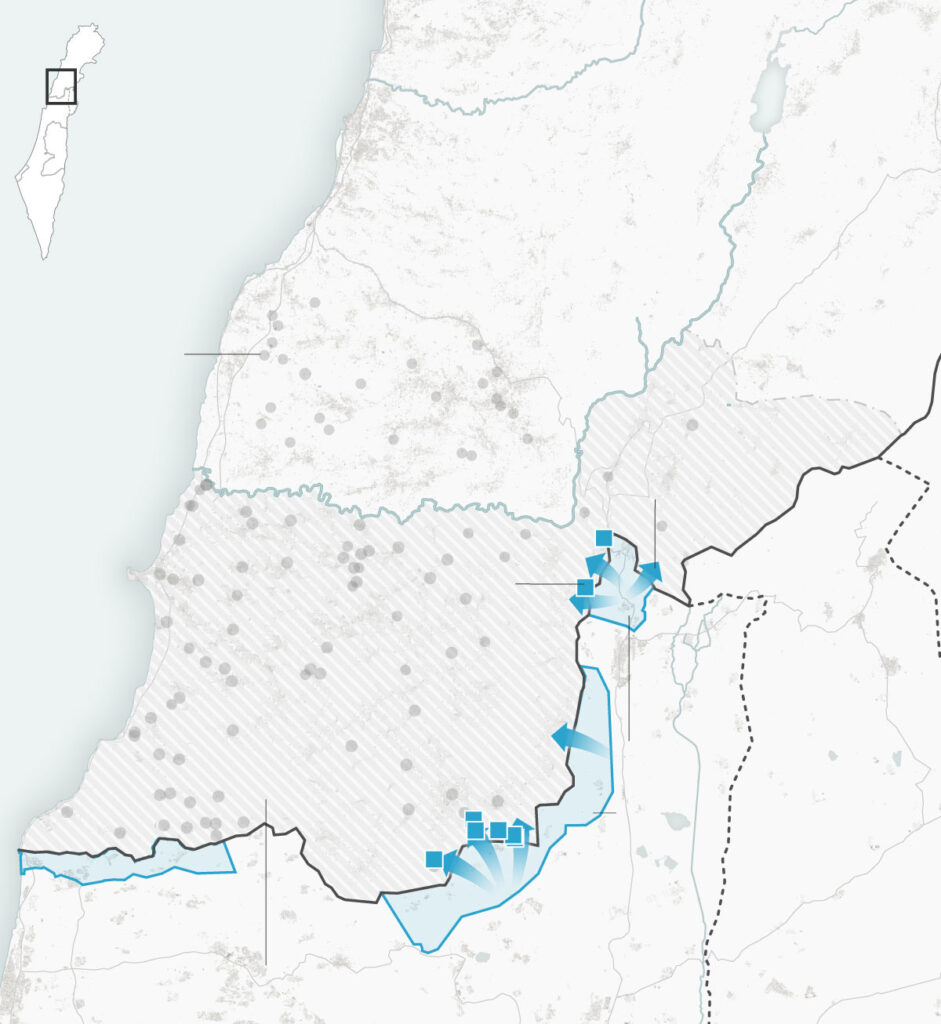
The Ḥizb Allah troops not only showed great knowledge about the area and unexpected resilience after much of its leadership had been assassinated recently but could successfully keep the Israeli troops at bay by bombarding all their gathering posts along the border. And just like the Israeli forces tried to bombard the hinterland behind the borders, Ḥizb Allah also forced almost all Israeli settlements in the north to be evacuated. What is significant is that this deadlock came despite the Israeli forces using their most elite forces. Which are breaking down, a many inside leaks clearly show. There is no reliable information about the losses of Ḥizb Allah, but until 11 October at least 30 Israeli soldiers died and 100 severely wounded in the fighting.

At the same time, along with the intensifying Israeli bombardment against Beirut and the al-Biqa‘ Valley Ḥizb Allah also intensified its missile strikes hitting Haifa and Ṣafad ever more severely and even Tel Aviv sporadically. A recent video published by Ḥizb Allah shows sending in its reconnaissance drone above Haifa indicating the new targets. This all comes within the policy of Tel Aviv for Beirut, village for village, city for city. Meaning that the official Israeli goal to make the settlers in the north return is not only unlikely in the close future, but very soon an even bigger wave of refugees might start to move from Haifa.
The Irani Strike. Devastating strike or just “fireworks”?
On 1 October night, the Iranian Revolutionary Guards Missile Forces launched between 150 and 200 missiles against Israeli military targets under the code name Operation True Promise 2. This time the drones were abandoned and mostly the more modern hypersonic Fattāḥ missiles were used. The main targets were all military, once again avoiding the civilian targets. These were reportedly three airbases, Nevatim, Tel Nof, and Hatzerim, all hit during the attack. The other main target was the Mossad headquarters in Galilot, an outskirts of Tel Aviv, also several hits.
Video showing that Iranian missiles kept pouring down on the Nevatim Base constantly
Though in addition, and probably not by coincidence the main gas production facility at ‘Asqalān was also hit, as the first indication that Iran can severely damage the energy grid.
Video showing that the Iranian missiles hit the gas extraction facility at ‘Asqalān, which serves most of the gas for the Israeli regime
The success of the Iranian retaliation to the previous Israeli attacks was, and still highly debated. Iran claims that above 90% of the missiles reached their targets and caused severe damage in all airbases. Also that at Nevatim, several F-35 jets were completely destroyed. Tel Aviv right after the strike claimed that there were no casualties and no damages, and most of the Iranian missiles were shut down in midair.

Some Arab opinions, mostly skeptical about Iran immediately said that it was nothing more than a public show, “fireworks”. Very similar opinions soon emerged by in the Western press as well, gradually admitting some casualties, like one Palestinian dying from debris, claiming that it was an almost complete failure and achieved nothing.
What makes this, and most Israeli claims highly questionable are not the pictures eventually published in the Western press showing Nevatim and some of the damages, only debating these images, but that right after the attack for more than 24 hours there was so-called “digital cloud” over these bases. This can be achieved either by spreading special particles in the air above the target constantly, practically blinding the satellites, which is a very costly and difficult thing to do, or demanding the publicly available civilian satellite to blur the images. And here the latter is much more probable.
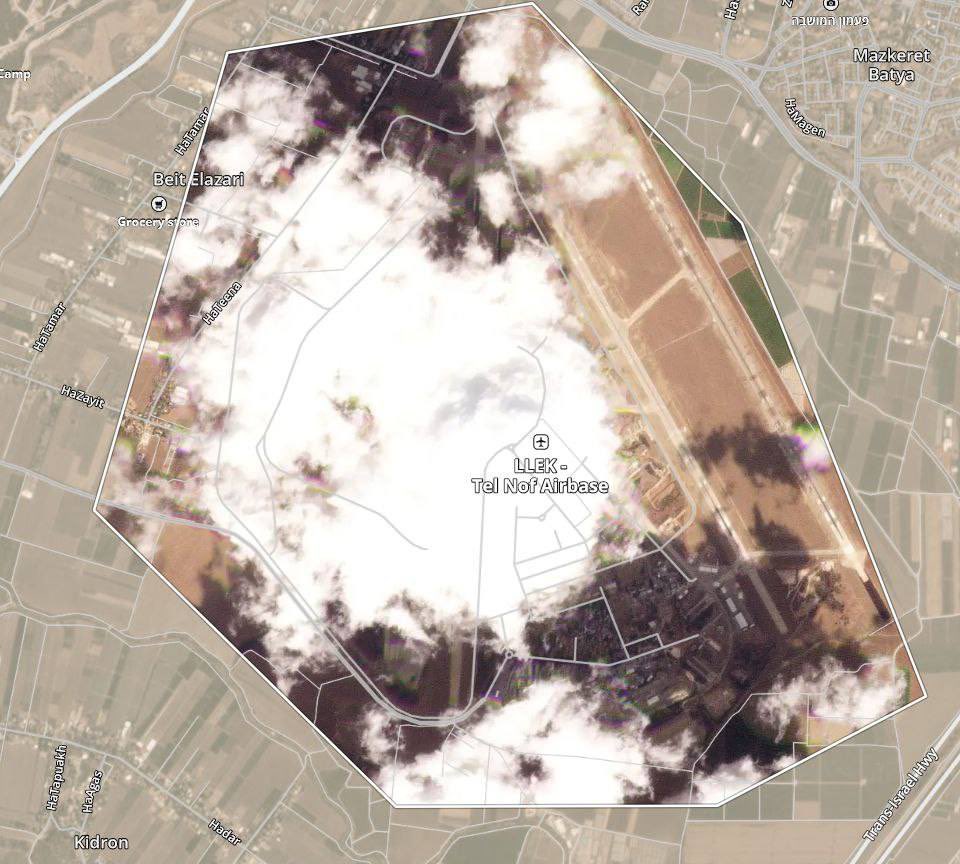
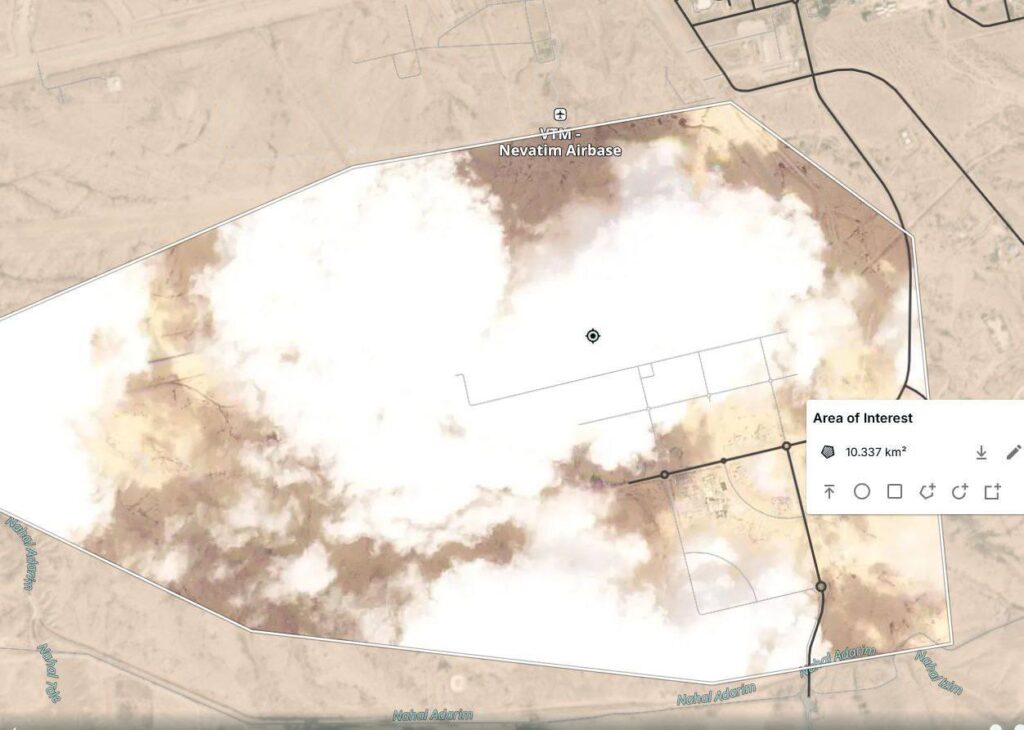
The reason why the Israeli regime blurred the images about the bases is clear. After a large number of videos were already seen and available on the internet showing that missiles kept hitting these bases the “nothing happened” version was unsustainable, but knowing the damage it needed time to present an “explainable image”. And this possibility is more consistent with the suggestion that some of the F-35s were hit. The likelihood that the Iranian strike was largely successful can also be deducted by the anger of Washington and the Israeli establishment promising retaliation, but not actually daring to provoke another strike.
Beyond the exact places of impact, it is very clear that a very large number of missiles did reach the Israeli military and Tel Aviv. It is also clear that Iran could have sent a much bigger wave. Which proves that the famed Israeli missile defense system is far from being so perfect as it is claimed, despite the massive American help the Israeli military is vulnerable.
With the exact timing and the dozens of videos showing the impacts, Iran scored a massive victory, even if the real impact on the Israeli military was little. Because Tehran showed that it dares to act and it is capable. And right at the time Tel Aviv was about to march into Lebanon, it was stepping up its support. With every single day Tel Aviv is just vowing to response but not actually daring to hit back, which hasn’t been their custom so far, the image of a strong Iran is growing.
A religious war
Since the land operation began against Lebanon, and specifically after the Iranian Operation True Promise 2, the Israeli narrative took a very clear shift. In part to justify the war that started in Gaza and now expanded to Lebanon, but also to reframe it deflecting some of the pressure and to create a narrative more in line with the policy of Netanyahu before the Gaza war. Which had the idea that soon enough most of the Gulf states with Saudi Arabia at the forefront would normalize relations with Tel Aviv, and new economic coexistence would emerge, which would guarantee the long-term sustainability of the Israeli regime and make all resistance in the region irrelevant and cornered.
The war that started on 7 October 2023 totally undermined this track. Firstly because of the war itself, once again proving that solving the Palestinian matter with a large-scale regional normalization and an apparent “deal” with the Palestinians was not viable, as they clearly reject this. Secondly because of the brutality of the war, which officially appears to have claimed the lives of some 43 thousand Palestinians in Gaza, but an article in the well-respected medical journal Lancet already in July feared that the real number might be as high as 186 thousand deaths. And thirdly because of the statements of many Israeli cabinet members talking about the total eradication of Gaza’s population and forcing them to flee to the neighboring countries. Which understandably caused huge concerns to the neighboring Arab states, even those that had officially arranged diplomatic ties with Tel Aviv.
Under such circumstances it was impossible for the Gulf state, even for those who previously considered the idea of what Netanyahu was talking about in some form, to establish relations with Tel Aviv. Due to the public outcry and the well-foreseeable diplomatic repercussions no government could endorse such a project, despite the considerable American pressure for it.
Which posed a double-sided dilemma. How to get out of the war with no winning strategy, but still crushing all opposition in the region, and how to revive this project, when the political climate made this clearly impossible?
The new narrative started to emerge in the summer, gained momentum when the operations against Lebanon were already in sight, but became a dominant talking point after the Iranian missile strikes. This new Israeli narrative channeled through its influential supporters in the media and its representatives in the states friendly to Tel Aviv completely rephrased what is happening now, and what is about to come. Completely stepping over the Palestinian matter and the war in Gaza, as an “already closed chapter” and “just war of retaliation”, it contextualizes the current status as a war that Tel Aviv fights not just against extremists, but a Shia block that is threatening the whole region. Therefore what is needed, and what American diplomacy should be focusing on is hammering out a new block in the Middle East between the “West” – primarily meaning the USA -, Tel Aviv, and the Sunni world that would eradicate the threat the Shia powers mean in the region. Meaning the Israeli troops in Lebanon are only fighting to crush Ḥizb Allah, hitting back to Iran after the missile strikes crippling it and then gradually eradicating any such threat in Syria, Iraq, Yemen, and whenever it might emerge. Doing so, the Israeli army would “do a service” to the projected new Gulf allies – mostly Sunni states -, which in general are concerned about the growing influence and possible nuclear power of Iran, and with a strong alliance they could guarantee that this threat would not emerge ever again. And since Tel Aviv played the biggest role in this, “naturally” it would play the leading role in this new power block, which is to be galvanized by the economic partnership envisioned by Netanyahu even before. A charming, but deeply flawed concept.
This talking recently became absolutely clear, not just by the rapidly expanding airstrikes against Syria, now aimed at specifically civilian targets in Damascus and even Russian positions along the coast, but by a news report on Israeli Channel 14 on 8 October.
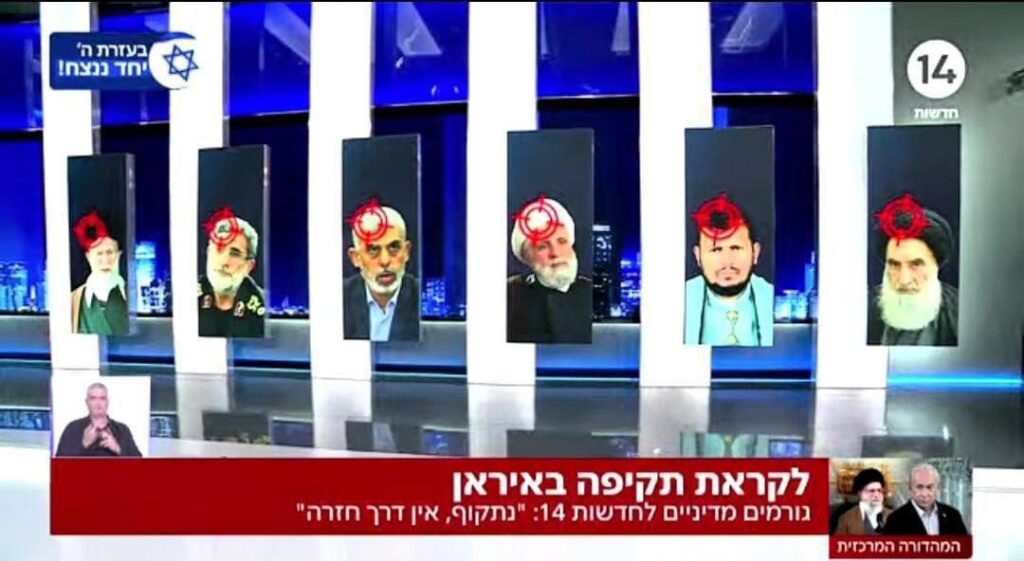
The targets on the picture from left to right Iranian Supreme Leader as-Sayyid ‘Alī Hāmeneī, Commander of the Iranian Revolutionary Guards Jerusalem Forces Esmā‘īl Qaānī, Ḥamās military leader in Gaza Yaḥyā Sinwār, Ḥizb Allah Deputy Secretary General Na‘īm Qāsim, Leader of the Anṣār Allah Movement as-Sayyid ‘Abd al-Malik al-Ḥūtī and Iraqi Grand Ayatollah ‘Alī as-Sīstānī. This not only shows whom the Israeli establishment views as main enemies to be assassinated soon, but also the range of the future operations Tel Aviv projects coming. Eliminating Ḥamās in Gaza, and with it all Palestine opposition, breaking Ḥizb Allah and occupying a large part of Lebanon, crushing the al-Ḥūtī Movement in Yemen – and thus baiting Saudi Arabia to join -, killing the leaders of the Iranian state
and army and most interestingly, killing one of the biggest Shia religious authorities, the only Grand Ayatollah in Iraq. Thought strangely no Syrian target was included. The last target, Grand Ayatollah as-Sīstānī is a particularly telling indication.
Already at the age of 94, Grand Ayatollah as-Sīstānī, though one of the biggest Shia religious authorities, is not particularly close to the Iranian state, or its core ideology, and though a conservative and a patriot, he is particularly known to be a very peaceful personality. He is not part of the Axis of Resistance. He had a very clear position against the war in Gaza and Lebanon and called for supporting the Palestinian and Lebanese people, yet he is not a military personality and though he has influence over all Shia groups in Iraq, he is not exactly close to the Iraqi Islamic Resistance. Putting him on the list has no military purpose, much more to invoke sectarian sentiments as if the war was conducted solely against the Shia and its main figures. Yet this idea falls apart very easily. First of all, Yaḥyā Sinwār, just like the overwhelming majority of the Palestinian population and the whole Ḥamās, is Sunni. And also not a core member of the Axis of Resistance. Ḥamās itself is not part of it, though the Gaza war and the whole Palestinian matter bring them to the same platform. So how could a “religious war” fought against the “Shia dominance” be fought primarily against a Sunni movement and a largely Sunni population, which is now a concern of most Muslim communities?
The whole idea that Tel Aviv would lead a regional struggle against the alleged Shia dominance, to which the Sunni states could join, or at least accept and be thankful for it is a clearly flawed idea, thought well presentable in the West, as knowledge about the Middle East is much weaker. Altogether eight Arab states that has ever recognized the Israeli state. Mauritania broke all relations in 2010 and revoked this recognition, the agreements with Sudan have never been formally ratified and nothing came of it, and though in Oslo the Palestinian Authority recognized Israel that has a very shaky legality now. That leaves us with only five Arab states with formal relations with Tel Aviv, Morocco, Egypt, Jordan, the Emirates, and Bahrain. These are Sunni states with the exception of Bahrain, which is an overwhelmingly Shia country with a Sunni leadership. From another point of view, out of the only four Shia-dominated countries in the world, Azerbaijan, Iran, Iraq, and Bahrein, two of them have official relations with Tel Aviv, which is much higher them in the Sunni world overall.
Looking from the perspective of the targets, Lebanon has a significant Shia population, but the country is so diverse that no denomination has a clear majority, Yemen is a mostly Sunni country, Iraq is mostly Shia, but its government is not, Syria has an arguably Shia leadership – thought very very different from that of Iran, or Iraq -, yet the majority of the population is Sunni, just like most Palestinians. So while this “religious war” fought against the “Shia dominance” largely hit Sunnis, and in Lebanon Christians also opposed the Israeli aggression, would that target Bahrain as well?
This is a mishmash of ideas clearly designed to project the current war against any opposition to Tel Aviv in the region and any support for Palestine as a regional conflict in which the Israeli regime is not alone, the war is expandable and the former plans are revivable. All obviously playing on the concerns in Jordan, Egypt, and the Gulf, not as much about the Shia, but specifically about Iran. Which has been the ultimate concern of Tel Aviv for decades and the basis of all cooperation with Jordan and Egypt.
There is nothing new in the core of this strategy, it is only rephrased. Back in the ‘50s, when the social and political dynamics of most Arab states – and at that time not all of them were independent – were very volatile, the Israeli ideologists were tempting the smaller Muslim communities, like the Druze and the Alawites as being threatened by the Sunni majority, and only a strong Jewish state, another religious “outcast” can understand and protect them. And thus Tel Aviv nurtured such separatist ideas. This tone shifted in the late ‘70s to the ‘90s with Lebanon at the focus, hinting that Lebanon, which was created as a Christian state, is about to be absorbed by Muslims. Therefore Jews and Christians should struggle together against this threat, as only they, the only non-Muslims can understand each other. The only aim was to find stabile local support for the occupation of Lebanon. Which to some extent worked, even setting up a South Lebanese Arms, until it totally collapsed in 2000. And even in 2006 when the Israeli forces attacked Lebanon Tel Aviv was trying hard to revive this connection, yet it completely failed. The very same idea is being repackaged now, as if Tel Aviv was to “save” the Sunni world from a Shia threat, not only abandoning the previous versions of this project but having even bigger contradictions and less ground.
The idea, however, is nonetheless very dangerous, as it can invoke sectarian tensions, mostly appealing to the most extreme Sunni elements – like Dā‘iš interestingly absent from the Gaza war – and might gain some appeal to certain Sunni political decision-makers. The real danger is that it foreshadows attempts to an even bigger war by Tel Aviv in the region gradually causing an all-out sectarian chaos, in which Tel Aviv can pull back and charm the Gulf states for protection and support.
The prospect of a regional war
Exactly because of the very desperate predicament of the current Israeli establishment, in their eyes, the conflict now is a war for survival. As we have indicated recently. The situation greatly resembles the conditions of the war against Lebanon in 2006. At that time the Bush administration was indicating plans for the “New Middle East”, reshaping it under American-Israeli dominance, when Syria was pushed back from the country in 2005, and some appeal still existed among Christians for an Israeli-patronized Lebanon. That eventually broke down as the Olmert government at that time faced way bigger internal problems and saw no rationale in continuing an invasion that broke down. That was a primarily American project.
This time the idea is very similar when Netanyahu is talking about a “New Middle East”, now under Israeli-American dominance. But now the American establishment is less devoted. Not only the upcoming elections are undermining this project, but also none of the candidates have clear support, a vision for getting involved so deeply in the Middle East once again with very dubious outcomes when priorities should be completely elsewhere.
Times have changed significantly. Iran is far less isolated and distrusted than it was in 2006, it has a much more stabile government, and its military capabilities have improved significantly. Its BRICK membership, the strategic partnership with China, and the very deep economic and military ties with Russia all make Iran far more stabile than it was in 2006, and has more allies in the region. But more significantly, the Iranian-Saudi reconciliation signed in China in March 2023 started to gain substance. Tehran is no longer enemy number one for the Gulf, as a number of states now have good relations with it. The recent visit by President Pezeškiyān to Doha on 3 October – so days after Operation True Promise 2 – meeting many of the GCC leaders showed that, when on the brink of a regional conflict Saudi Foreign Minister Ibn Farḥān was talking about “turning the page on the differences”. Iranian Foreign Minister ‘Arāqčī has also visited Riyadh on 11 October hitting a very cordial tone, which was well received.
The rivalry between Riyadh and Tehran did not diminish and there might be voices in the Gulf that advocate that it might just be beneficial to see Iran weakened. But there is no enthusiasm anymore for supporting a regional war against it. That, however, does not mean Tel Aviv would not try this anyway, for it the stakes are very high.

